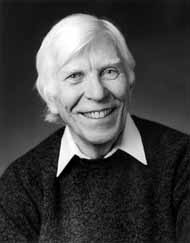 |
|
Tollestrup Looks a Step Beyond the Next Step by Mike Perricone
NLC, VLHC, TESLA--no, not these. These candidates for the "next" machine for high-energy physics don't address the question Tollestrup has in mind. He wants to know what's next after what comes next. "These are basically all machines that we understand how to build," he says. "The step after that next step is what's really murky." Tollestrup, one of the Tevatron's "godfathers" and a charter member of Fermilab's CDF collaboration, nurtures a continuing hope to clarify that further step, or at least to make its murkiness interesting to young physicists. He has organized accelerator workshops in the past, and campaigned for volunteers to join him in an investigation of muon colliders and neutrino factories. Now he's hosting another seminar, "Accelerator Science and Your Future," in Wilson Hall's One West conference room, from 3 p.m. to 5 p.m. on Tuesday, February 20, with refreshments afterwards. "Always a good idea to feed graduate students," Tollestrup says. He thinks there will also be food for thought. The message of the seminar: there are research opportunities and careers waiting in accelerator physics, opportunities that can make a difference in the future of physics as well as the future of a physicist. For example: Fermilab's Beams Division, which operates the accelerator complex, lists seven openings in accelerator science (one Applications Physicist, five Associate Scientists, one Applied Scientist). Run II and the Higgs search will focus attention on the Tevatron.
A recent $2.5 million grant from the State of Illinois Board of Higher Education established the Illinois Consortium for Accelerator Research, aimed at "extending Fermilab's lifetime as the best choice of future accelerator technology and physics projects in Illinois." ICAR's five members are the Illinois Institute of Technology, University of Illinois at Champaign-Urbana, the University of Chicago, Northwestern University and Northern Illinois University. The grant injects increased funding for accelerator research into universities to build up their accelerator programs. Other university positions are appearing as well. FERMINEWS recently ran an ad for a research associate in accelerator physics at Cornell University. "For a long time, we haven't been putting enough money into accelerator R&D," Tollestrup says. "The result is a real talent deficit now, just when we need new people. In the future, there's a real crisis coming up. We need to do something about this." The uncertainties surrounding both the next-generation machine and the next next-generation only serve to raise the stakes. Both cost and hardware are major issues. "The ATLAS detector at CERN will cost about $500 million," Tollestrup says. "They are making that kind of investment because they're pushing the technology. We have had 20 years of investment in detectors. Now we must balance that by investing in accelerators." The next next-generation machines must push against the limits of the current technology, Tollestrup maintains, because NLC, VLHC and the others represent the technology limit. That makes R&D the critical factor. "If you're going to spend billions for a new accelerator," Tollestrup says, "it's critical to get things right. The cost is so high that, if you make mistakes, the effects on the field would be devastating." That's the scenario to avoid at all costs, and the best strategy is hiring and training new hands.
"We just don't know how to build a 500 TeV machine," Tollestrup says. "People have got to get into the field and understand how to accelerate beams, or we're going to hit an end point. We have to have the smart young people to do it."
|
| last modified 2/16/2001 email Fermilab |
FRLsDFx9eyfrPXgV
 What's next? That's what Alvin Tollestrup's inquiring mind wants to know.
What's next? That's what Alvin Tollestrup's inquiring mind wants to know.